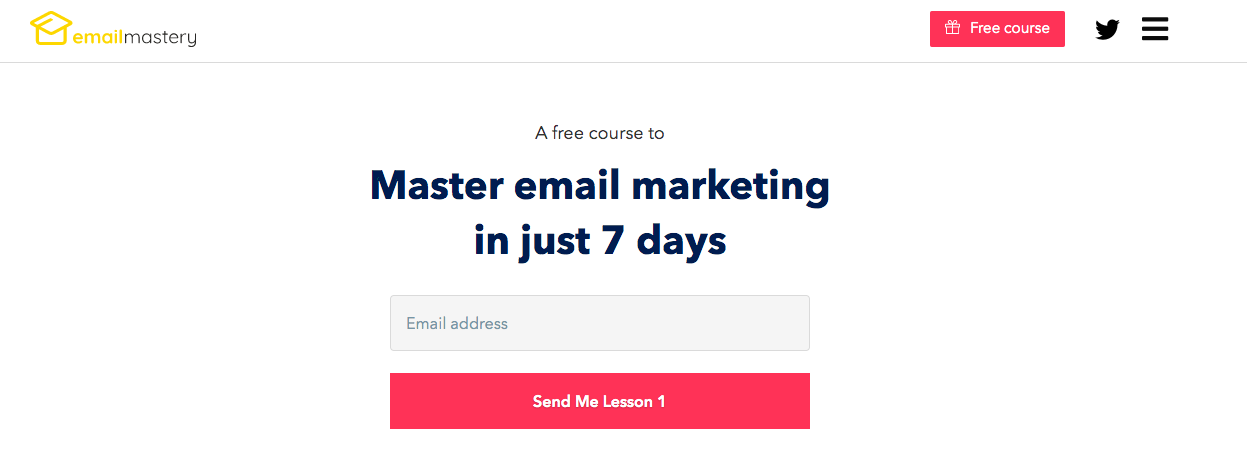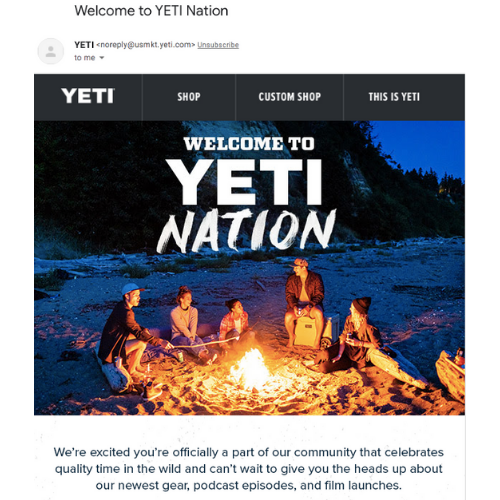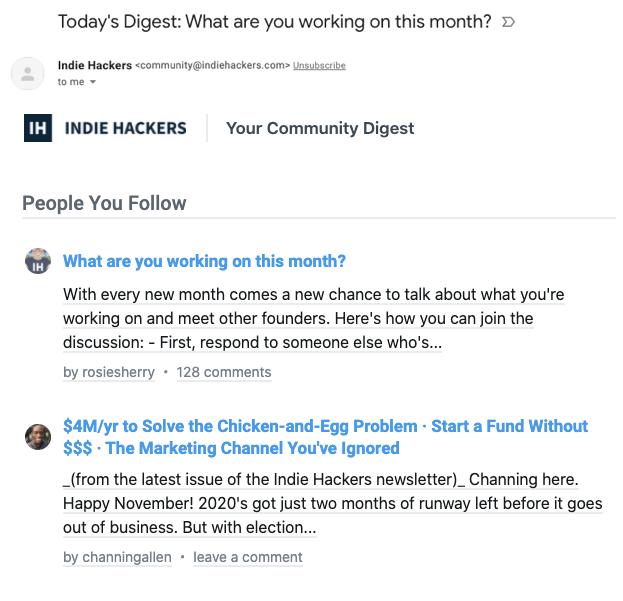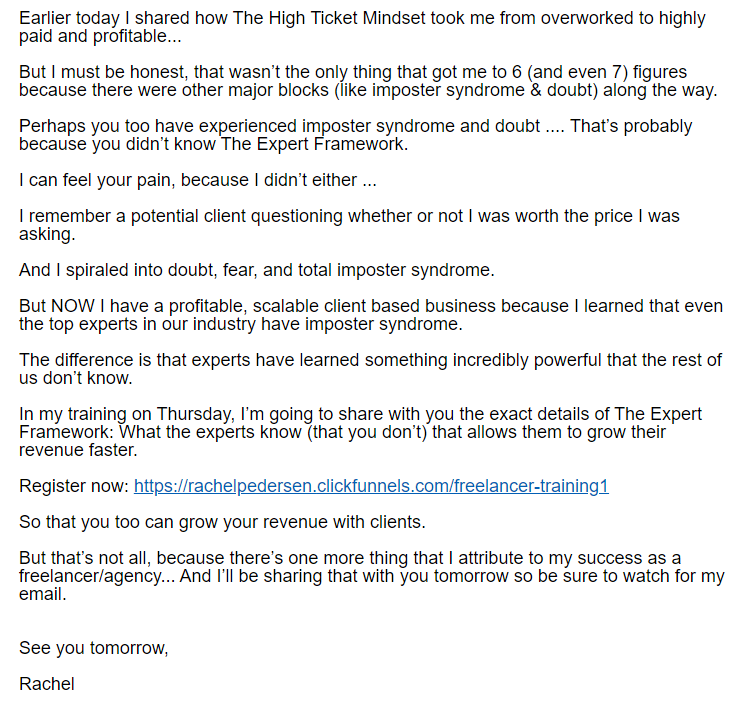How do you write effective subject lines?
At first, that seems like a simple question… one that just requires a few tips and tricks to answer.
But it’s actually a pretty complicated question.
For example, before you can write an effective subject line, you have to know why you’re sending the email in the first place, what goal you want to accomplish, who you’re sending it to, the content of the email, and the objective of the overall marketing campaign which that email is a part of.
That’s a lot…
But don’t cover your eyes.
Even though it’s a loaded question, writing great subject lines is mostly a science.
And in this guide, we’re going to discuss how you can write effective subject lines, every time, for each different type of email.
We’ll include tons of examples, too.
Let’s dive right in.
Why Do People Open Emails, Anyway?
Before we can start writing great subject lines, we have to understand what compels people to open emails in the first place.
Why do people open some emails and not others?
Ultimately, it comes down to interest. If the email creates interest — via the subject line, pre-header, and sender name — then the person will open it.
And there are 3 different types of interest that get people opening emails.

Here they are.
1. Relational Interest
To be fair, the concept of relational interest isn’t really related to subject lines… but it is the most compelling reason that someone opens an email.
This is the email you open because you recognize the sender and care about their content, regardless of the subject line or preheader.
Most often, these emails come from family members and friends… and they are probably the first emails you open when browsing through your inbox.
Because you have a relationship with the sender, you’re going to open.
However, this type of interest isn’t limited to family and friends… businesses can also create relational interest with their subscribers.
It’s just more difficult.
With family and friends, you already have a vested interest in the person’s life. They could ramble on about unimportant stuff in their life, and you’d still probably open, read, and respond to their email.
That’s because you know the person’s intent, and you care about the person.
So the question is… how do you get people to care about your brand in the same way that they care about friends and family?
The answer is simple but not easy — you must build equity and provide a lot of value, show yourself to be consistent and honest, resonate with your target market’s own beliefs, and allow time to pass.
No meaningful relationship is built on a single email, after all.
With enough time and consistency, people will start to care about what you have to say. They’ll start opening your emails more often just because they’re your emails. They’ll engage and click… they’ll even tell their friends.
That’s the type of relationship you’re aiming to build with your subscribers.
In a sense, that’s the peak of the email marketing mountain-top — to create and maintain meaningful relationships with your subscribers, relationships that compel them to click on your emails over and over again.
But, of course, this is a long-term process and not something you’ll pull off overnight.
You’ll have to use the other interest triggers in your subject lines to get people opening right off the bat. You’ll probably even want to keep using them as time goes on so that you can keep people’s interest and inspire people to open who don’t yet have a relationship with your business.
Just always remember that your subject lines — and even your emails themselves — will be far more effective if people feel a connection with your brand.
Relational interest is the ultimate reason that you want people opening your emails… because they like you, they trust you, and they want to hear what you have to say.
Pro Tip: Using personalization and segmentation tags within your emails — the recipient’s name, their unique interests, their demographic, or anything else specific to them — is one great way to build a relationship with your audience. This audience-based email marketing says, “We care about who you are, and we’re working to only send you content that you’ll be interested in.” In a world where your audience receives loads of irrelevant emails every single day, that’s a powerful message.
2. Self Interest
This is the primary reason that people will sign up for your email list in the first place — because you offered them something that’s going to help them.
All human beings are self-interested — that is, we’re naturally drawn to things that we think will benefit us, drive us forward, or help us out of a difficult situation.
That’s why appealing to a person’s self-interest without asking them for anything in return makes for such a powerful lead magnet.
In fact, that’s what we do with our own lead magnet!

By offering people a free 7-day course to master email marketing, we’re helping to solve our target market’s biggest challenge.
And all we ask for in return is the person’s email address.
When someone believes that your offer is really going to help them, giving you their email address is quite a small request.
So how does this apply to subject lines with high open rates?
Well, you can — and should — apply the self-interest trigger to some of your email subject lines.
Here are some examples of what that looks like that we pulled from our own inbox…
- Want my entire content strategy for free?
- 6 possible causes of your migraines
- The 5 most common investor questions (and answers)
- No tricks! Treat yourself to an extra box free!
- A few final resources to help you succeed as a copywriter
These subject lines are particularly effective with new subscribers.
They get people opening right off the bat and, if your content is good, they also teach people to trust your future content.
Your new subscriber onboarding sequence is a great place for this type of subject line (not counting the first welcome email).
3. Emotional Interest
The final reason that someone opens an email is that they have an emotional interest.
Maybe they disagree with the subject line and so they want to see what you have to say. Maybe the subject line is so bizarre that they just have to know what’s inside the email. Or maybe the subject line promises some inspiration or a powerful story.
Here are some examples of the emotional-interest trigger in action…
- Anyone else really really really misses people?
- Imposter syndrome
- Seven terrible traps that trip up entrepreneurs
- Wanna be a sloth with a v8 engine
- Develop healthy habits for a healthy mind
These subject lines create curiosity, pluck heart-strings, or make us laugh.
And by making people feel something, you can improve your open rates and build a relational brand at the same time — a brand that people can connect with.
Ultimately, these three types of interest work in harmony together to get people opening your emails and connecting with your brand.
The end-goal is to get people opening your emails because of relational-interest; they know you and trust you.
But this all starts by appealing to people’s self-interest and then their emotional interest.
With enough time, those emails will allow your audience to develop a powerful, long-term relationship with your brand.
Still, not all emails are the same… and neither are all subject lines.
Some subject lines work better or worse for different types of emails. So next, we’ll take a look at when you should use what types of subject lines.
Understanding How Subject Lines Work In All Different Types Of Emails
We’ve already discussed the three different reasons that people open emails.
But when should you use those interests? And how, specifically, do you craft effective subject lines for each different type of email?
That’s what we’re going to talk about now.
1. The Transactional Email Subject Line

When we talk about transactional emails, we’re talking about order confirmations, digital receipts, shipping updates, and review requests.
These emails are usually pretty straight-forward and simple.
In our opinion, the subject line should be no different.
You can add a little bit of tonal flair or personality to your transactional emails, but for the most part, they should be clear and easy to search for in case recipients need to reference them in the future.
Here are some examples of functional subject lines for transactional emails that serve their purpose well…
- Thank You For Your Purchase
- Your receipt from Apple
- Reset your password
- Order Confirmation
- Confirm Your Subscription Here!
If you can add a little flair to these subject lines that help to represent your brand, go for it… but never at the cost of clarity.
2. The Welcome Email Subject Line

Your welcome emails — which includes your first welcome email and your initial drip sequence — are a great place to use self-interest subject lines.
Remember: your welcome sequence represents the time-period when people are just getting to know your business.
Here’s a real case study:
As of yet, they don’t know if they trust you, like you, or want to listen to you — they only have an inkling.
Your goal is to prove to them that you’re worth listening to.
And that’s why self-interest is so great.
For the first email of your welcome sequence, you don’t necessarily have to use self-interest, though. In fact, it’s probably a better idea to do something that prepares new subscribers for what’s coming.
Such as…
- You made it here! Here’s what’s next…
- Ready to dive in?
- Welcome to the club!
- We’re excited to have you!
And here are some welcome sequence self-interest subject lines that perform really well (sent after the initial welcome email)…
- these THREE practice projects will get you ready for PAID work
- How much should you charge your clients?
- Big opportunity inside
- Want my best sales call script for free?
Think of this as the phase of your relationship with your subscribers where you’re trying to flatter them… you want to provide so much free value here that they will keep listening to you into the future.
Just ask yourself, “What does your target most urgently need help with?”
And then, in those first emails, help them with those things and craft subject lines to fit your already compelling content.
3. The Newsletter Subject Line

Your newsletter emails are where you’ll have the most creative freedom with your subject lines.
These are the emails you send weekly, twice per week, or daily to your subscribers. And they have a lot of different goals. Some of these emails will try to make sales, some of them will offer discounts, and some of them will tell inspirational stories or promote recent content that you’ve published elsewhere.
But all of these emails should be focused on strengthening your relationship with your subscribers.
In fact, that should be their first goal.
Like we mentioned previously, the goal here is to get people opening your emails simply because those emails are coming from you.
But you can sprinkle self-interest triggers and emotional-interest triggers throughout these newsletter emails as well.
Because really… there isn’t a relational-interest subject line.
(Relational interest is simply the end goal you’re aiming for)
Creating a relationship with your subscribers means that they’ll open more of your emails because they trust you and they like your content, but that doesn’t mean you should skimp on providing them with click-worthy hooks and delightful emails.
There is a caveat here, though.
You don’t want to overdo these triggers.
Sending too many emails that play off of people’s self-interest or emotional interest can backfire and make it seem like your brand isn’t personal at all.
Sometimes, sending emails with simple, basic subject lines can help people feel like they’re interacting with an actual person rather than a big business.
Here are some examples…
- Exhausted
- High ticket
- Change the world
- Just gave this speech
- Do your feet hurt?
- It’s MONDAY babyyyy!
For people who don’t already know and trust you, these subject lines are probably going to be ignored. But for people who love your brand and your content, these emails might actually perform better than those with big, promising subject lines.
There’s only one way to find out: test, test and test!
4. The Sales Email Subject Line
What about emails where you’re trying to make sales?
Some of your newsletter emails might fall into this category, but we felt that the sales subject line deserved its own section.
Because the interest trigger you use in a sales email will depend on the nature of your email — you can use any of the three triggers.
You can connect with people emotionally by telling a story…
Subject line : Imposter Syndrome.

Or you can appeal directly to people’s self-interest…

Relational interest, as well, has a big impact on whether people open, click, and convert — probably the biggest impact.
(Which is why your welcome journey is so important!)
So what do great sales subject lines look like?
Here are some great self-interest triggers…
- How to get “High Ticket Secrets” for FREE
- only pay AFTER… IF you like it?
- 7-day offers start now!
- Want 50% off? (only ‘til midnight!)
And here are some great emotional interest triggers…
- Dang it… I screwed this up 🙁
- how you can help => “World Day Against Trafficking”
- Did that really happen?
- How to start a movement
Although, statistically speaking, it’s important to note that the word “Free” is far less effective than most email marketers think it is. Research by Mailchimp produced some unexpected results, showing that “Free” in the subject line isn’t great at getting clicks.
Generally speaking, “Freebie” actually works better.
Additionally, “Urgent”, “Important”, “Breaking”, and “Alert” all increase open rates by creating a sense of urgency. However, you should only use these words when it’s consistent with the actual content of your email — you don’t want to mislead people.
(Also, note that using these words can sometimes trigger spam filters, so it’s important to use them sparingly and only when they are relevant to the message)
5. The “Other” Email
We’ve covered four different types of emails, but we know you’re thinking of other types of emails you send that we haven’t covered.
So this section is for those “other” emails.
If you find yourself crafting the subject line for an email that doesn’t fall under one of the previous categories, here’s an easy step-by-step approach…
- What Is the Style of the Email? — What type of email are you sending? What is the goal of your email? Why are you sending it? This should make a significant difference in the type of subject line that you craft.
- Which Interest Trigger Will Be Most Consistent With the Email’s Content and Style? — Which of the 3 interest-triggers makes the most sense for this email? Should you appeal to people’s self-interest? Should you create an emotional experience? Or is this a time when you should depend on people’s relationship with your brand? The interest-trigger you choose should be consistent with the type of email that you’re sending.
- Craft 3 Totally Different Subject Lines — Once you’ve chosen the best interest-trigger for your subject line, craft 3 different subject lines with totally different hooks. If you need help ideating, check out this surprisingly useful subject line generator.
- Choose Your Favorite and Test Your 2nd Favorite — Review your subject lines with someone you trust and choose your 2 favorites. Then test to see which one performs the best. It’s a good idea to make split testing a consistent process within your business. Here’s an awesome guide to testing your email subject lines. And here’s our favorite tool for assessing the quality of test results.
Conclusion
Now you have a process for crafting effective subject lines.
You know why people do or don’t open emails, and you know how to bake those psychological interests into your subject lines.
But enough from us…
How do YOU craft compelling subject lines?
Let us know on Twitter.
discuss on twitter